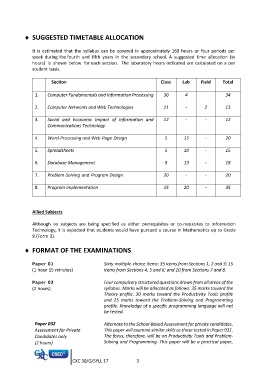Page 980 - SUBSEC October 2017_Neat
P. 980
SUGGESTED TIMETABLE ALLOCATION
It is estimated that the syllabus can be covered in approximately 160 hours or four periods per
week during the fourth and fifth years in the secondary school. A suggested time allocation (in
hours) is shown below for each section. The laboratory hours indicated are calculated on a per
student basis.
Section Class Lab Field Total
1. Computer Fundamentals and Information Processing 30 4 34
2. Computer Networks and Web Technologies 11 - 2 13
3. Social and Economic Impact of Information and 12 - - 12
Communications Technology
4. Word-Processing and Web Page Design 5 15 - 20
5. Spreadsheets 5 10 - 15
6. Database Management 5 13 - 18
7. Problem-Solving and Program Design 20 - - 20
8. Program Implementation 15 20 - 35
Allied Subjects
Although no subjects are being specified as either prerequisites or co-requisites to Information
Technology, it is expected that students would have pursued a course in Mathematics up to Grade
9 (Form 3).
FORMAT OF THE EXAMINATIONS
P a p e r 0 1 Sixty multiple-choice items: 35 items from Sections 1, 2 and 3; 15
(1 hour 15 minutes) items from Sections 4, 5 and 6; and 10 from Sections 7 and 8.
P a p e r 0 2 Four compulsory structured questions drawn from all areas of the
(2 hours) syllabus. Marks will be allocated as follows: 35 marks toward the
Theory profile, 30 marks toward the Productivity Tools profile
and 25 marks toward the Problem-Solving and Programming
profile. Knowledge of a specific programming language will not
be tested.
Paper 032 Alternate to the School-Based Assessment for private candidates.
Assessment for Private This paper will examine similar skills as those tested in Paper 031.
Candidates only The focus, therefore, will be on Productivity Tools and Problem-
(2 hours) Solving and Programming. This paper will be a practical paper,
CXC 30/G/SYLL 17 3

